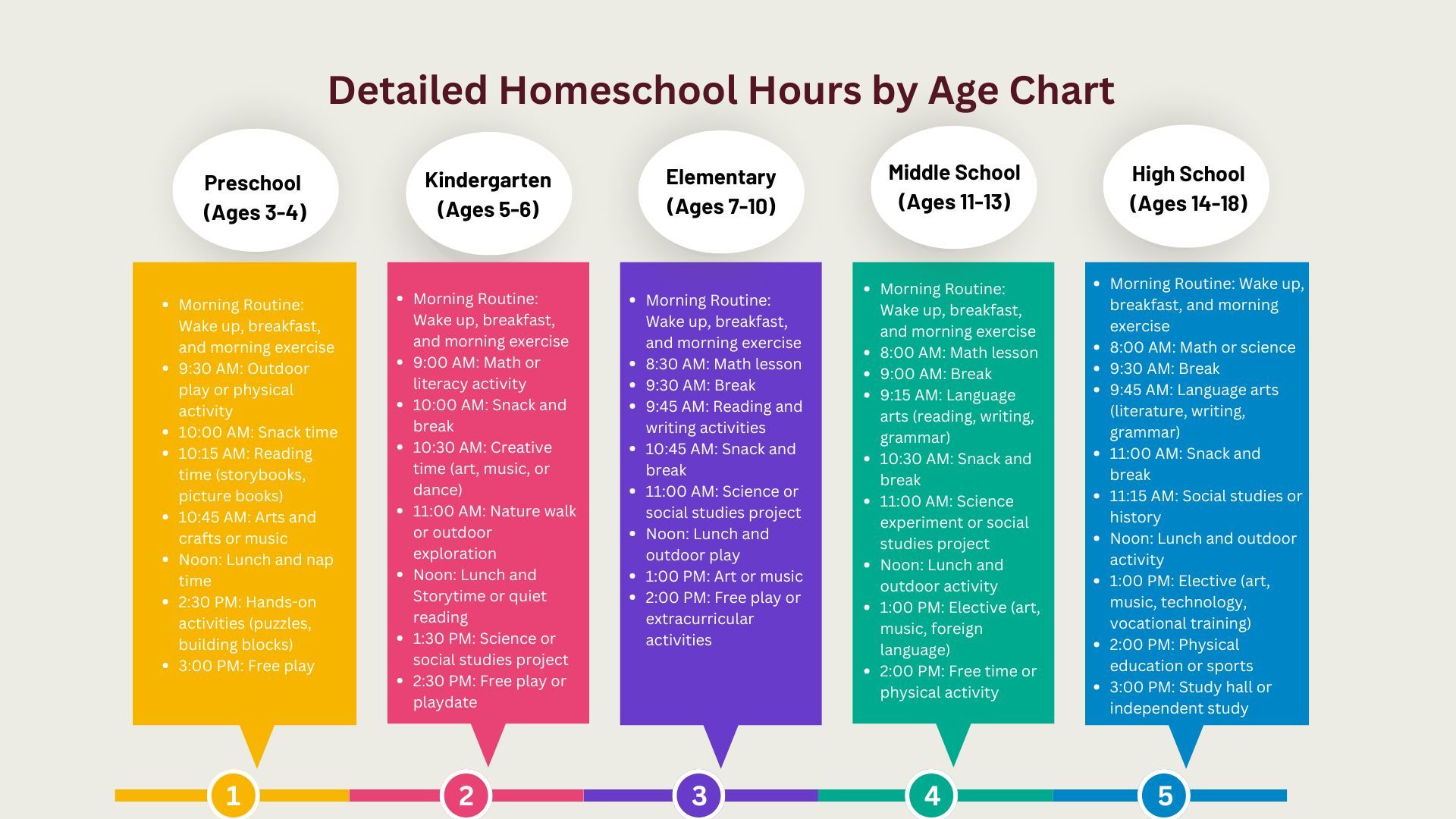Discover the ideal study hours for your child with our detailed homeschool hours by age chart. Tailor their schedule for effective learning.

Did you know that over 3.1 million students were homeschooled in the United States in 2021-2022 representing approximately 6% of school-age children? This number has been steadily increasing, reflecting a growing trend among parents seeking more control over their children’s education. One of the critical aspects of homeschooling is determining the appropriate number of study hours per day, which can significantly impact a child’s learning experience. The homeschool hours by age chart is an essential tool for parents to ensure their children receive a balanced and effective education tailored to their developmental stages.
In this blog post, we will explore the homeschool hours by age chart in detail, providing guidelines for various age groups and practical tips for creating an optimal homeschool schedule. By understanding and implementing these recommendations, you can foster a love for learning in your child while ensuring their academic success.
In This Blog
ToggleSection:1 Understanding Homeschooling
What is Homeschooling?
Homeschooling is an educational approach where parents assume the primary responsibility for educating their children at home. This method allows for a highly personalized education, where the curriculum and teaching methods can be adjusted to suit the child’s individual learning style, interests, and pace.
Importance of Structured Homeschool Hours
While homeschooling offers flexibility, having a structured schedule is crucial for creating a productive learning environment. The homeschool hours by age chart helps parents strike the right balance between flexibility and structure, ensuring that educational goals are met and children develop essential discipline and time management skills.
Section:2 General Guidelines for Homeschool Hours
Key Factors Influencing Homeschool Hours
Several factors influence the appropriate number of homeschool hours per day
- Child’s Age and Developmental Stage: Younger children typically have shorter attention spans and need more frequent breaks, while older children can handle longer periods of focused study.
- Learning Style and Pace: Some children grasp concepts quickly and may need less time to cover the material, while others require more time and repetition.
- State Regulations and Requirements: Different states have varying laws regarding the minimum number of homeschool hours and record-keeping requirements.
Section:3 Detailed Homeschool Hours by Age Chart
The homeschool hours by age chart provides general guidelines for the number of study hours suitable for different age groups. These recommendations are flexible and should be adjusted based on your child’s needs and learning pace.

Preschool (Ages 3-4)
Suggested Hours: 1-2 hours per day
At this age, focus on play-based and exploratory learning activities to develop motor skills, language, and social interactions.
Sample Schedule
- Morning Routine: Wake up, breakfast, and morning exercise
- 9:30 AM: Outdoor play or physical activity
- 10:00 AM: Snack time
- 10:15 AM: Reading time (storybooks, picture books)
- 10:45 AM: Arts and crafts or music
- Noon: Lunch and nap time
- 2:30 PM: Hands-on activities (puzzles, building blocks)
- 3:00 PM: Free play
Kindergarten (Ages 5-6)
Suggested Hours: 2-3 hours per day
Kindergarteners benefit from a mix of structured learning and free play, focusing on foundational skills in reading, writing, and math, along with creative and physical activities.
Sample Schedule
- Morning Routine: Wake up, breakfast, and morning exercise
- 9:00 AM: Math or literacy activity
- 10:00 AM: Snack and break
- 10:30 AM: Creative time (art, music, or dance)
- 11:00 AM: Nature walk or outdoor exploration
- Noon: Lunch and Storytime or quiet reading
- 1:30 PM: Science or social studies project
- 2:30 PM: Free play or playdate
Elementary (Ages 7-10)
Suggested Hours: 3-4 hours per day
Elementary-aged children are ready for more structured learning, focusing on developing core academic skills while incorporating hands-on and interactive activities.
Sample Schedule
- Morning Routine: Wake up, breakfast, and morning exercise
- 8:30 AM: Math lesson
- 9:30 AM: Break
- 9:45 AM: Reading and writing activities
- 10:45 AM: Snack and break
- 11:00 AM: Science or social studies project
- Noon: Lunch and outdoor play
- 1:00 PM: Art or music
- 2:00 PM: Free play or extracurricular activities
Middle School (Ages 11-13)
Suggested Hours: 4-5 hours per day
Middle school students need a balance of academic rigor and extracurricular activities, with an emphasis on independent learning and critical thinking.
Sample Schedule
- Morning Routine: Wake up, breakfast, and morning exercise
- 8:00 AM: Math lesson
- 9:00 AM: Break
- 9:15 AM: Language arts (reading, writing, grammar)
- 10:30 AM: Snack and break
- 11:00 AM: Science experiment or social studies project
- Noon: Lunch and outdoor activity
- 1:00 PM: Elective (art, music, foreign language)
- 2:00 PM: Free time or physical activity
High School (Ages 14-18)
Suggested Hours: 5-7 hours per day
High school students are preparing for higher education or entering the workforce, so their schedule should include advanced academic subjects, college prep, and vocational training.
Sample Schedule
- Morning Routine: Wake up, breakfast, and morning exercise
- 8:00 AM: Math or science
- 9:30 AM: Break
- 9:45 AM: Language arts (literature, writing, grammar)
- 11:00 AM: Snack and break
- 11:15 AM: Social studies or history
- Noon: Lunch and outdoor activity
- 1:00 PM: Elective (art, music, technology, vocational training)
- 2:00 PM: Physical education or sports
- 3:00 PM: Study hall or independent study
Section:4 Customizing the Homeschool Schedule
Personalizing Learning
Every child is unique, and their homeschool schedule should reflect their individual needs and learning styles. Use the homeschool hours by age chart as a starting point and adjust based on your child’s interests and pace. Like:
- A child who loves reading may spend more time on language arts and less on structured math activities.
- A child with a passion for science might have extended time for experiments and projects.
Incorporating Breaks and Downtime
Regular breaks are essential to keep your child refreshed and engaged. Incorporate short breaks between study sessions and ensure there is ample time for play and relaxation.
- Use timers to signal the start and end of study periods.
- Alternate between different types of activities to keep your child interested.
- Allow flexibility in the schedule to accommodate your child’s natural rhythms and energy levels.
Section:5 Practical Tips and Best Practices

Engaging Learning Activities
Make learning fun and interactive by incorporating hands-on activities, educational games, and real-world experiences. Like:
- Science: Conduct simple experiments at home using household items.
- Math: Use cooking and baking to teach measurements and fractions.
- Language Arts: Create a family book club or writing journal.
Tracking Progress and Adjusting Hours
Regularly assess your child’s progress and adjust the homeschool hours by age chart and activities as needed. Use a variety of assessment methods to get a comprehensive view of their learning.
- Keep a daily or weekly log of activities and hours.
- Use quizzes, tests, and projects to evaluate understanding.
- Have regular discussions with your child about their learning experiences and challenges.
Section:6 Common Challenges and Solutions
Homeschooling comes with its own set of challenges, but with the right strategies, these can be effectively managed.
Common Challenges
- Keeping children motivated and engaged.
- Balancing homeschooling with other responsibilities.
- Ensuring comprehensive coverage of all subjects.
Practical Solutions
- Incorporate variety in teaching methods and activities.
- Designate a specific study area that is completely free of distractions.
- Use online resources and join homeschooling communities for support and ideas.
Conclusion
Understanding and implementing homeschool hours by age chart is essential for creating an effective and enjoyable homeschooling experience. By customizing the schedule to fit your child’s unique needs and incorporating engaging activities, you can foster a love for learning and ensure academic success.
Experiment with different schedules, be flexible and adjust as needed to find what works best for your family. Remember, homeschooling is a journey of discovery for both you and your child.
Share your experiences, ask questions, and connect with other homeschooling families to build a supportive community.
You may also be interested in : Benefits of Homeschooling vs Public Schooling – What’s Best for Your Child in 2024?
FAQs
1. How many hours should a preschooler spend homeschooling each day?
Preschoolers typically benefit from 1-2 hours of homeschooling each day, focusing on play-based and exploratory learning activities. This helps develop motor skills, language, and social interactions in a fun and engaging way.
2. What are the recommended homeschool hours for elementary-aged children?
Elementary-aged children should spend 3-4 hours homeschooling each day. This includes structured learning activities to develop core academic skills, complemented by hands-on and interactive activities to keep learning engaging.
3. How can I customize my child’s homeschool schedule?
Customize your child’s homeschool schedule by using the homeschool hours by age chart as a starting point. Adjust based on your child’s interests, learning pace, and individual needs. Incorporate a mix of structured and unstructured activities, and include regular breaks to keep them engaged.
4. What factors influence the number of homeschool hours needed?
Factors include the child’s age and developmental stage, learning style and pace, and state regulations. Younger children need shorter, more frequent learning sessions, while older children can handle longer periods of focused study.
5. How can I track my child’s progress in homeschooling?
Track progress by keeping a daily or weekly log of activities and hours, using quizzes, tests, and projects to evaluate understanding, and having regular discussions with your child about their learning experiences and challenges.




